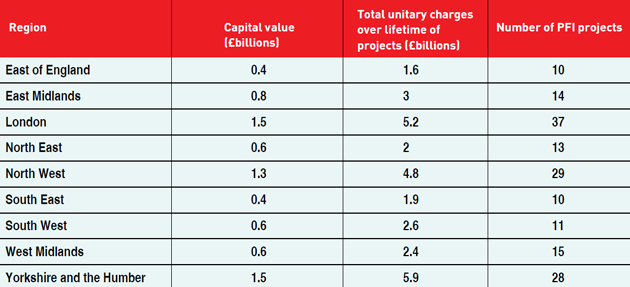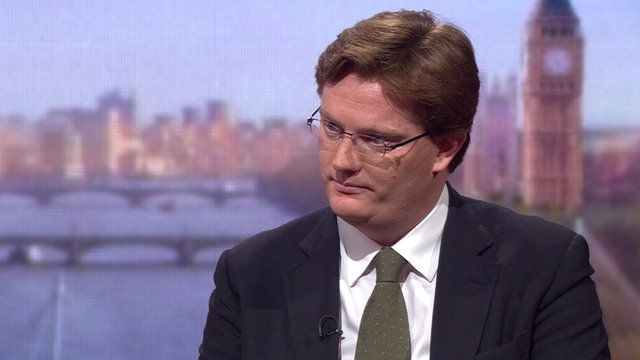Every state school in England would have to pay more than £1 million each to clear the debt owed to the private firms that built new schools under PFI contracts, an analysis of Treasury figures by Schools Week has found.
While schools are already struggling under the burden of hefty financial commitments, Schools Week can reveal the overall repayments will continue rising until they peak in 2024/25.
The figures suggest emerging PFI problems will only get worse in the coming years as schools struggle while budgets tighten.
An analysis of the latest official Treasury figures shows taxpayers have already paid £7.5 billion in contract repayments – known as the unitary charge – for school PFIs up to the end of 2014/15.
The unitary charge is the fee the public sector pays for the services it receives from PFI projects.
The charge includes the repayment for the building, as well as costs for services, such as cleaning and maintenance.
The amount currently paid back is close to the actual overall capital value – total worth of the buildings – which is listed as £7.8 billion.
Schools Week can reveal the total amount of cash the government estimates is still left to pay totals more than £22 billion over the remaining years of the contracts.
The remaining debt works out at more than £1 million for each of England’s 21,728 state-funded schools.

The total charges are expected to be nearly £30 billion over the lifetime of the 168 PFI projects. This is nearly four times as much as the total capital value of the projects.
School repayments will peak at £1.2 billion in 2024/25. This is for two reasons: yearly inflation rises written into the contracts and the type of repayment schemes agreed by local authorities.
Schools Week has been told the favoured finance schemes chosen by authorities is for smaller repayments at the start of the contract, with larger repayments in the future.
The figures also show schools in five regions are tied into these contract repayments until 2039 (when a current year 11 would turn 40).
It also means schools are tied to service contracts with hefty and disproportionate prices. During the National Audit Office’s 2011 investigation into PFI it was revealed one school paid £333 to have a lightbulb changed.
Some of these prices have become more reasonable since standardised contracts were brought in.
However, the long-term commitment to these contracts still means schools have less flexibility if they need to make savings in future.
Savings drive
The Treasury is aware of the crippling costs of PFI. A savings drive was launched in 2012 to save £1.5 billion by finding efficiencies in PFI contracts.
Government departments urged the authorities responsible for procuring the contracts to review their current deals.
It said last March the drive had resulted in savings of more than £2 billion from the country’s 700 PFI projects. 
Danny Alexander (pictured right), former chief secretary of the Treasury, has said there is a further £2 billion saving to be made. He said: “This programme has ensured proper management of contracts between the private sector and the public sector, ensuring that taxpayers are getting the best possible value for their investment.”
The latest Treasury PFI figures were published in 2014. Schools Week understands updated figures for the two-yearly report are due to be published soon – which should show whether more savings are feasible.
Is there anything schools can do?
Even when a school becomes an academy, the local authority remains the PFI contract holder.
So any changes to contracts have to go through the local authority. There are a range of options available that could decrease costs – including audits, benchmarking and gold plating.
Craig Elder, a partner in the public sector team at law firm Browne Jacobson, said any change to agreements mostly depended on the relationship between the local authority and the PFI contractor, which could be variable.
But he said most contractors have signed up to a code of conduct that states they will consider changes for best value.
Several PFI experts have told Schools Week that local authorities are paying their contracts without fully knowing if they are getting what they pay for. That suggests there is plenty of scope to find savings in contracts.
Individual schools have also found it hard to encourage local authorities to negotiate changes.
Consultant Marcus Orlovsky said this is because a local authority’s PFI contract would normally cover multiple schools, and scrutinising the complex contracts to make minor savings wasn’t worth their time.
But as local authorities now face bigger cuts, they have been increasingly proactive. Slough council, for instance, has renegotiated its PFI contract to take back control of its utility bills, which has “generated year-on-year savings”.
Philip Nye contributed research
OTHER STORIES FROM OUR PFI INVESTIGATION:
Investigation: Who will pick up the PFI tab?
The future: Fair Funding Formula could be toxic for PFI schools
The future: Will schools get a better deal under PF2
The PFI firms: Multi-million pound profits from flipping contracts
The PFI firms: The low-key investment firm that owns 260 UK schools






Can’t help feeling the local or national government people who drew up PFI contracts were incompetent, that contractors are making a mint without being held accountable, and that there will be a lot of people saying “we told you that’s what would happen”.
How many schools were included in those 168 projects?